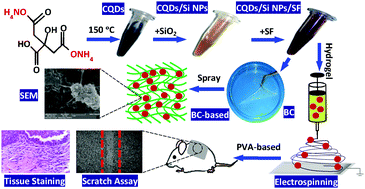PVA based nanofiber containing CQDs modified with silica NPs and silk fibroin accelerates wound healing in a rat model
Abstract
In recent years, applying various wound dressings with antibacterial activities to expedite tissue repair stages has gained remarkable attention. The intertwined three-dimensional structure of nanofibers provides unique spaces for carrying drugs and repair agents during the wound healing process. In this research, a carbon quantum dot (CQD)/silica nanoparticle (Si NP)/silk fibroin (SF) nanocomposite was synthesized, and two novel wound dressings, a BC-CQD/Si NP/SF nanocomposite and a PVA–CQD/Si NP/SF nanofiber, were prepared by Spray Printing and Electrospinning methods and successfully characterized. The water-uptake capacity of the BC-CQD/Si NP/SF nanocomposite has been optimized to evaluate its swelling behavior. To determine the antibacterial effects of the synthesized materials both MIC and Optical Density (OD) methods were performed, and the results imply that materials have high antibacterial activity and could successfully inhibit the growth of both S. aureus and E. coli bacteria. Cell toxicity, viability, and proliferation on NIH 3T3 fibroblast cells with the MTT assay have proved that the CQD/Si NP/SF nanocomposite not only has no toxicity but also can accelerate cell viability and proliferation. To assess the effect of the CQD/Si NP/SF nanocomposite on cell migration and in vitro wound healing scratch, a wound assay was performed, and the nanocomposite exhibits the ability to promote wound healing. The PVA–CQD/Si NP/SF nanofiber was used to investigate wound healing in an animal model. The results show that the PVA–CQD/Si NP/SF nanofiber effectively accelerates the skin and hair follicle regeneration. Therefore, the PVA–CQD/Si NP/SF nanofiber is a promising wound dressing for inhibiting bacterial growth and promoting skin wound repair and hair regeneration.



 Please wait while we load your content...
Please wait while we load your content...